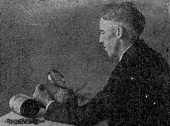Testing the Law of Probability

Pope R. Hill, a professor at the University of Georgia during the 1930s, wanted to find out. But he thought coin-flipping was too imprecise a measurement, since any one coin might be imbalanced, causing it to favor heads or tails.
Instead, he filled a can with 200 pennies. Half were dated 1919, half dated 1920. He shook up the can, withdrew a coin, and recorded its date. Then he returned the coin to the can. He repeated this procedure 100,000 times!
Of the 100,000 draws, 50,145 came out 1920. 49,855 came out 1919. Hill concluded that the law of half and half does work out in practice.
If you have absolutely nothing better to do, you can head over to Random.org, which hosts a virtual coin toss, and try to outdo Hill by clicking the "flip coin" button 100,001 times. Make sure to record your results. Although I doubt a virtual coin toss would be considered truly random, even though random.org claims their randomness "comes from atmospheric noise, which for many purposes is better than the pseudo-random number algorithms typically used in computer programs."
Comments
Commenting is not available in this channel entry.

Category: Experiments | 1930s